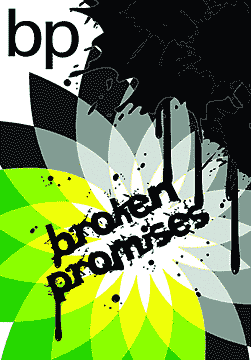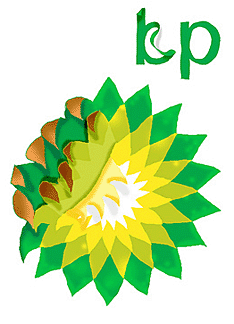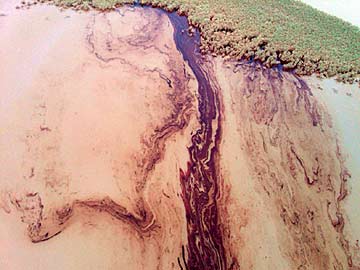Art Contest: BP Logo Redesign

As BP’s broken underwater oil well in the Gulf of Mexico continues to gush over 100,000 barrels of oil per day into the fragile ecosystem, and as sheets of the thick sticky crude start to fill the delicate marsh lands of the Mississippi Delta – Greenpeace UK has launched an art competition to redesign the BP corporate logo.
The contest is open to professional and non-professional artists from around the world. Greenpeace UK says that the current corporate logo needs “a makeover to better suit a company that invests in tar sands and other unconventional oil sources like deep water oil,” and that a redesigned logo should better reflect BP’s “dirty business.”
Starting on May 20, 2010, the design contest will run for six weeks, ending on June 28, 2010. The environmental group says the winning logo design will be “used by us in innovative and exciting ways as part of our international campaign against the oil company,” and will be placed in high profile locations, as well as featured in newspaper and magazine advertisements. Entries will be judged by a panel of artists from the design and marketing professions, whose identities will be revealed as the competition draws to a close.
Submitted artworks can be created in any media, the only criteria being that the re-worked logo adheres to the concept of exposing BP, and that the logo is easy to comprehend and reproduce. Non-professional artists and students are encouraged to submit their ideas and concepts, as Greenpeace UK will provide such a contest winner “a day with a top graphic designer to transform your idea into a final product.”

John Sauven, the Executive Director of Greenpeace UK, said the following regarding the launch of the logo competition; “BP’s famous green logo is there to distract us from what this company really stands for. This company has chosen to extract the last drops of oil from deep sea wells and the tar sands of Canada, instead of developing the clean technologies that can actually help beat climate change. That’s why we’re calling in the experts. We’re hoping that the design community and the public will help us come up with a logo that will actually reflect BP’s obsession with dirty oil. This is a competition with a difference, because we’re planning to use the winning entry all over Britain in a high profile Greenpeace campaign that the company will find impossible to spin.”
Complete details on the competition and how to submit an entry, are available on the Greenpeace website, at: www.greenpeace.org.uk
It should be noted that Greenpeace UK launched the design competition by simultaneously deploying trained climbers to scale the front entrance of BP’s London headquarters, where the Greenpeace activists replaced BP’s large corporate flag with a redesigned banner of their own.
Greenpeace UK released the following statement to the public regarding the event; “Our climbers have scaled the front of BP’s London HQ to present them with a logo that we think might suit them a little better. Our logo has been ‘improved’ with the addition of a bit of oil and a tagline that reads ‘British polluters.’ It’s an OK effort, but we’re sure you can do much better. So today we’re launching a competition to get you to redesign BP’s logo to suit a company that’s investing in unconventional oil like the Canadian tar sands.”

One of the Greenpeace climbers, Ben Stewart, made the following statement;
“The oil spill in the Gulf of Mexico can be traced back to decisions made in this building. Under Tony Hayward’s leadership (the company’s chief executive) BP has taken huge risks to pump oil from ever more remote places, while slashing investment in the clean energy projects that could actually help reduce our dependence on oil and beat climate change.
BP’s bright green logo is a pathetic attempt to distract our attention from the reality of what this company is doing, both in the Gulf of Mexico but also in places like the tar sands of Canada. Tony Hayward’s reckless approach will cause more disasters unless action is taken to stop him.”
On a related note, at last someone aside from me has bothered to mention the financial relationship between BP and the Los Angeles County Museum of Art (LACMA), which I have been writing about in great detail since March 2007.
In his brief May 18, 2010 article, BP Grand Entrance at LACMA looking not-quite-so-grand, Los Angeles Times art critic Christopher Knight noted the ongoing “epic environmental tragedy” caused in the Gulf by BP, and playfully suggested that “LACMA might want to think about commissioning a work of art that would be apt for the BP Grand Entrance.”

Of course, in October of 2007 I had proposed just such an artwork in my article, Another Oil Slick at LACMA, which detailed BP having to “pay a whopping $373 million in an out of court settlement designed to stop U.S. Justice Department criminal indictments against the global energy giant’s law-breaking in the United States.” In that piece I proposed an architectural design (shown at right) for a “BP Grand Entrance” at LACMA more in keeping with the oil company’s terrible record of environmental destruction.
But Knight’s article also mentioned that BP funded the creation of an exhibit at the Aquarium of the Pacific in Long Beach, which has officially been dubbed, the “BP Sea Otter Habitat.” Now that is a concept difficult to imagine.
Four years ago BP gave a $1 million “donation” to the Aquarium of the Pacific, which used the petro dollars to build its new BP Sea Otter Habitat, an attraction that “transports visitors to California’s Central Coast,” providing a recreation of a rocky coastline where visitors can “peer underwater and discover the busy world of sea otters as they swim and interact amongst kelp and fish.” The BP Sea Otter Habitat presents an accurate peek at the pristine environment of California’s Central Coast, with its crystalline waters and giant kelp beds filled with mollusks, crustaceans, and innumerable fish. As a former scuba diver, that ecosystem is well familiar to me, and it has long been a source of constant inspiration and awe. But that unspoiled natural beauty is a far cry from the “Dead Zone” now being created in the Gulf of Mexico by BP.

While sea otters do not live in the Gulf of Mexico, Louisiana’s Department of Wildlife and Fisheries says that 600 animal species are directly imperiled by BP’s ongoing ecological disaster; 445 species of fish, 45 mammals, 32 reptiles and amphibians, and 134 bird species.
On May 20, biologists of the Breton National Wildlife Refuge found the first oil covered brown pelican to have died from exposure to BP’s massive oil spill – and there are some 4,500 pelicans nesting at the refuge; which brings me back to the BP Sea Otter Habitat at the Aquarium of the Pacific.
To launch its new BP exhibit, the Aquarium of the Pacific announced its “Sea Otter Poetry Contest.” Commencing May 20, 2010, and running until August 15, 2010, contestants worldwide are being asked to submit a poem no longer than 300 words on the theme of sea otters. Poems are to be judged in two categories: those penned by writers’ ages 13 through 20, and those written by authors over 21. All entries must be submitted digitally or by mail, by midnight Aug. 15, 2010. First Prize winners will have their works published in the Aquarium’s magazine and on the Aquarium’s website, plus assorted prizes for Second and Third Prize winners. The Aquarium of the Pacific will announce the winners on October 27, 2010. Details on entering the BP sponsored Poetry Contest can be found on the Aquarium’s website.
Poetry has always provided a means to touch the heart as well as the intellect, and many a poet has dedicated verse and rhyme to excoriate the evils of the day, using the evocative language of poetry as social protest – the BP sponsored Aquarium of the Pacific’s Sea Otter Poetry Contest presents no less an opportunity. I believe that every lover of the written word should submit a poem to this contest, as it is a creative way to denounce BP’s role in destroying our planet, as well as expressing our vision of humanity truly at peace with the natural world.
Though sea otters do not live in the Gulf of Mexico, creative writers will no doubt be able to pen verse that connects the aquatic mammal with the crimes against nature being committed by BP. For those who wish to submit a poem of outrage to the Sea Otter Poetry Contest, but hesitate to do so out of concern that the BP sponsored Aquarium will simply ignore the entry, simply “CC” an e-mail copy of your poem to Art For A Change – where I will post the best submissions on October 27, 2010, the very day the winners of the BP sponsored Poetry Contest are announced by the Aquarium of the Pacific.

